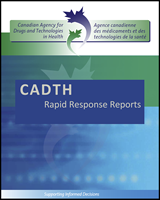Limited evidence suggests that DWI is more sensitive than CT for the early detection of stroke in highly selected patients. Based on clinical practice guidelines,9,11–15 the use of diagnostic imaging, whether with CT or MRI, appears to be an appropriate method to support a diagnosis for stroke or TIA.
The American Heart Association/American Stroke Association (AHA/ASA) guidelines recommend that patients with TIA should preferably undergo neuroimaging evaluation within 24 hours of symptom onset. MRI, including DWI, was the preferred brain diagnostic imaging modality. If MRI is not available, cranial CT was recommended.9 The Brazilian Stroke Society (SBDCV) guidelines state that cranial CT is essential in the emergency assessment of patients with acute ischemic stroke. Both cranial CT and MRI (including diffusion and gradient echo sequences) are recommended for patients with acute stroke, though the recommendation for brain CT is based on a higher level of evidence. The guidelines further state that multimodal neuroimaging can be useful for selecting patients for thrombolytic therapy with onset of symptoms with an indefinite duration or beyond 4.5 hours.11 The South African Stroke Society (SASS) guidelines recommend the use of cranial CT or MRI for patients with suspected stroke or TIA. The cranial CT recommendation was based on a higher level of evidence compared with MRI. According to the guidelines, CT brain scans can accurately determine the type and anatomy of the stroke. They further stated that if a CT scan is not feasible, patients may be required to be referred to another centre that is able to perform a CT or MRI scan.12 The National Collaboration Centre for Chronic Conditions (NCC-CC) guidelines state that patients with suspected TIA, for whom vascular territory or pathology is uncertain, should undergo DWI. Furthermore, the authors state that CT scanning should be used when MRI is contraindicated (for example, patients with a pacemaker, shrapnel, brain aneurysm clips and heart valves, metal fragments in eyes, or severe claustrophobia). Brain scanning with MRI with DWI should be performed within 24 hours following TIA.13 The European Stroke Organisation (ESO) guidelines recommend brain imaging with CT or MRI in all suspected stroke or TIA patients. The use of urgent cranial CT had a recommendation based on a higher level of evidence compared with MRI. The guidelines stated that a 24-hour CT scan should be available for centres managing acute stroke patients.14 The Institute for Clinical Systems Improvement (ICSI) guidelines state that patients presenting less than 24 hours since the initial clinical TIA should not leave the emergency department until undergoing or scheduling brain imaging with MRI or CT. MRI was described as the preferred diagnostic procedure as diffusion-weighted sequences may identify patients at particularly high risk of early major recurrence.15 With varying recommendations regarding the preferred diagnostic imaging modality, it is still unclear whether patients with suspected acute stroke or TIA should undergo MRI versus CT scans. While this does not represent a comprehensive search for clinical practice guidelines for stroke diagnosis, further detail regarding the recommendations for diagnostic imaging for stroke from these guidelines is included in Appendix 5.
Evidence regarding the use of expert clinical assessment is limited, thus further research is needed to identify if a comprehensive clinical assessment of symptoms is sufficient to support a diagnosis of stroke or TIA. While expert clinical assessment was used as the reference standard in each diagnostic imaging study included in this review, no literature on the use of expert clinical assessment for stroke diagnosis was identified. AHA/ASA guidelines state that patients with stroke should undergo clinical assessment along with neurological examination, and that a stroke rating scale preferably the National Institutes of Health Stroke Scale (NIHSS), should be used.9 Similarly other guidelines recommend the use of validated tools, such as the Recognition of Stroke in the Emergency Room (ROSIER) tool16 to evaluate patients suspected of stroke. The ICSI guidelines15 recommend that a qualified clinician should evaluate patients with TIA or minor stroke symptoms and initiate risk factor assessment and counseling. However, while tools to support clinical assessment have been recommended by various guideline groups, recommendations for the use of clinical assessment, without accompanying diagnostic imaging, appear to be lacking.

